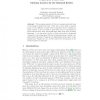Free Online Productivity Tools
i2Speak
i2Symbol
i2OCR
iTex2Img
iWeb2Print
iWeb2Shot
i2Type
iPdf2Split
iPdf2Merge
i2Bopomofo
i2Arabic
i2Style
i2Image
i2PDF
iLatex2Rtf
Sci2ools
APN
2001
Springer
2001
Springer
''What Is a Petri Net?''
The increasing number of Petri net variants naturally leads to the question whether the term “Petri net” is more than a common name for very different concepts. This contribution tries to identify aspects common to all or at least to most Petri nets. It concentrates on those features where Petri nets significantly differ from other modeling languages, i.e. we ask where the use of Petri nets leads to advantages compared to other languages. Different techniques that are usually comprised under the header “analysis” are distinguished with respect to the analysis aim. Finally, the role of Petri nets in the development of distributed systems is discussed.
| Added | 28 Jul 2010 |
| Updated | 28 Jul 2010 |
| Type | Conference |
| Year | 2001 |
| Where | APN |
| Authors | Jörg Desel, Gabriel Juhás |
Comments (0)

